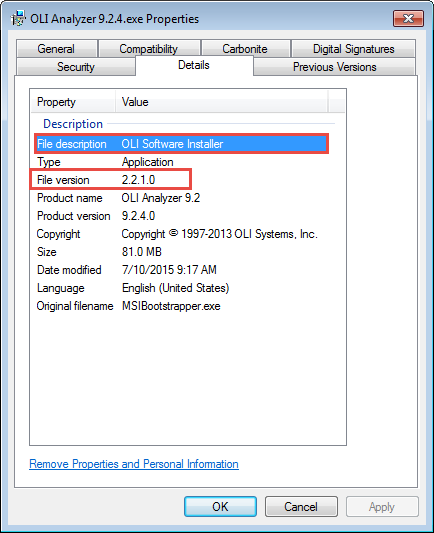Installing the OLI Software in Silent or Bootstrapped Modes
Contents
Installing OLI Software in Silent/Bootstrapped Modes
Installation packages for newer versions of OLI software products support command line options to facilitate bootstrapped (chained) and/or silent installations. The information in this article applies to OLI Software Installer packages having version 2.0.2 or higher.
Determining the Installer Version
The version number of an executable OLI software installation package can be obtained by viewing its “File version” property. File properties can be viewed in Windows Explorer by selecting “Properties” from the file’s context menu. Please note that the installation package version is distinct from the release version of the actual OLI product installed by the package.
Command Line Options
The following command line options are available:
Interaction level:
/q
Recommended non-interactive mode with minimal UI. Displays progress bar and fatal errors. Also prompts for elevation in case it is required.
/qn
Silent mode. Does not display any UI. Note that this switch would cause Windows not to prompt for elevation in case it is required and hence fail in that case.
/qf
Default. Executes installation with full UI.
Installation options:
/repair
Repairs an installation.
/uninstall
Uninstalls the product.
Miscellaneous options:
SERIALNUMBER=<Serial number>
Specifies the serial number to be used for installation. For example SERIALNUMBER=V2-AAAA-BBBB-CCCC-DDDD-EEEE-FFFF. There should be no spaces in the string. (See known limitations below).
LICSERIP=<Server address/name>
(Installer version 2.0.4 and above.) Specifies the license server for a client install with network license security.
LICSERPORT=<Port Number>
(Installer version 2.0.4 and above.) Specifies the license server port for a client install with network license security.
LICSERBINDING="ip_addr_port=<Server:port>"
(Superseded by LICSERIP and LICSERPORT. May not be supported in newer versions.) Specifies the license server and port (optional) for a client install with network license security. (See known limitations below).
Return Codes
The installer returns one of the following error codes upon execution:
0 (0x00000000): The installation process completed successfully.
-1 (0xffffffff): Invalid command line arguments.
-2 (0xfffffffe): Command line argument length is too long.
-3 (0xfffffffd): Could not create a temporary directory for installation files.
-4 (0xfffffffc): Windows Installer not found on the system.
-5 (0xfffffffb): Windows Installer version is unsupported.
-6 (0xfffffffa): Invalid installation action.
-7 (0xfffffff9): Windows Installer service could not be accessed
-8 (0xfffffff8): The user canceled the installation.
1603 (0x00000643): Generic Windows Installer error. Note that a missing/incorrect
Using License Information File
The installation package can also read license information from license information files that are sometimes distributed with OLI software products. These license files are typically named LA*.txt, LH*.txt or NH*.txt and contain licensing information for running OLI software. The installation package can read the serial number and additional information, such as, product data and serial data that are used in certain licensing scenarios, from this file. In order to use the license information file, the file name must be of the form LH*.txt or NH*.txt and must exist in the directory from which the installer is launched.
Known Limitations:
- The command line options of the form PROPERTY=<value> would cause an installer error if the <value> string is empty. A workaround is to wrap the empty value string with ‘\’-escaped quotes. Example: SERIALNUMBER=\"\". SERIALNUMBER=\"V2-AAAA-BBBB-CCCC-DDDD-EEEE-FFFF\" will also work.
- In installer versions 2.0.3 and lower, the LICSERBINDING value specified on the command line is incorrectly cleared when the installation is run in full UI mode.
- In installer versions 2.03 and lower, the ‘Product name’ and ‘Product version’ file properties are incorrectly set to the name and version of the installer instead of the actual OLI product installed by the installer.
Example
"OLI Studio 11.5.1.7.exe" SERIALNUMBER=V2-AAAA-BBBB-CCCC-DDDD-EEEE-FFFF LICSERIP=Gladiator LICSERPORT=25000 /qn
